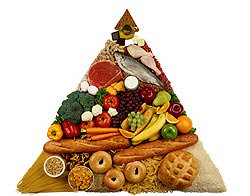Nutrition in the Acute Porphyrias
The following are general recommendations that may not apply to all patients with acute Porphyria. Individual nutritional needs vary and are affected by the nature and severity of the disease. Therefore, a physician should be consulted and the advice of a dietitian sought before implementing dietary recommendations for a complex medical condition such as Porphyria. Other recommendations may need to be added or substituted to meet the needs of an individual patient.
These general nutritional recommendations for acute Porphyrias are very similar to those for diabetes mellitus. Therefore, physicians and dietitians may find that dietary instructions given for a patient with acute Porphyria are not very different from that given for a disease they encounter much more frequently than Porphyria.
Nutritional recommendations for Acute Intermittent Porphyria (AIP), Hereditary Coproporphyria (HCP), Variegate Porphyria (VP) and ALAD Deficiency Porphyria (ADP) emphasize a high carbohydrate intake as part of a balanced diet that provides all essential nutrients. The recommendations include an adequate intake of dietary fiber, vitamins and minerals. The goals are to prevent acute attacks of Porphyria that may be related to diet, avoid deficiencies of nutrients, and maintain a normal body weight.
The following dietary guidelines are recommended:
- Energy intake should be prescribed at a level to maintain a desirable body weight.
- Carbohydrate intake should be 55 to 60 percent of total energy intake.
- Protein intake should follow the US FDA's RDA (Recommended Daily Allowance). This may be increased in elderly subjects, and reduced if there is kidney impairment.
- Total fat intake should be less than 30 percent of total calories. In individuals with high blood cholesterol levels, saturated fat should be less than 10 percent of total energy intake, polyunsaturated fat 6 to 8 percent, and the remainder monounsaturated fat.
- Cholesterol intake should be less than 300 milligrams per day.
- Artificial sweeteners are acceptable.
- Salt intake need not be restricted unless it is important for controlling hypertension. The management of high blood pressure (hypertension) may include salt restriction. This is not discussed here because most patients with Porphyria do not have persistent hypertension.
- Intakes of vitamins and minerals should meet the RDAs.
- Calcium intake in women should be at least one gram (1000 milligrams) daily.
- Iron intake should be adequate to avoid iron deficiency. Women with heavy menstrual blood loss and patients who have had frequent blood drawings due to illness and hospitalization may require greater intakes of iron. (Iron is a component of heme. Iron deficiency can compromise heme synthesis and may exacerbate Porphyria. Therefore, iron deficiency should be avoided in Porphyria. Early iron deficiency occurs before there is anemia (low blood count). Early iron deficiency can be detected by tests such as serum iron and iron-binding capacity and serum ferritin.
- Alcoholic beverages should be avoided. Alcohol stimulates the heme biosynthetic pathway in the liver and can itself exacerbate Porphyria. Alcohol has other harmful effects and can lead to weight gain. Some experts feel that small amounts of alcohol are not harmful in Porphyria while others feel that even small amounts should be avoided.
- Fiber intake should be about 40 grams per day but should not be increased above 50 grams per day. A high-fiber diet may increase the requirements for calcium, iron and trace minerals. High dietary fiber intakes should be avoided in patients with upper gastrointestinal problems (abnormalities in the esophagus or stomach) because sometimes excess fiber can accumulate in the form of "bezoars." Increasing dietary fiber intake sometimes causes abdominal cramping, diarrhea and flatulence. These can be minimized by increasing fiber intake gradually.
- Foods contain many natural chemicals that can stimulate the heme biosynthetic pathway. Although none have been definitively linked to attacks of Porphyria, the possibility that these chemicals might contribute should be kept in mind especially when attacks of Porphyria recur in the absence of a definite inciting factor. Some of the dietary factors that might have an adverse effect on Porphyria include charcoal-broiled meats (which contain chemicals similar to those found in cigarette smoke), and high intakes of protein. Probably none of these foods need to be completely avoided in Porphyria. However, it is important to consume a well-balanced diet and not to consume any particular type of food in excess. The best way to maintain a well-balanced diet is to learn to eat a variety of foods from what are commonly referred to as the four major food groups. Detailed advice on how to do this should be sought from a dietitian.
